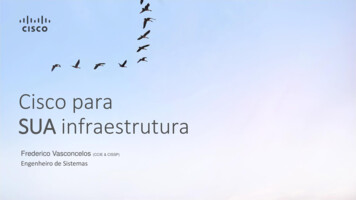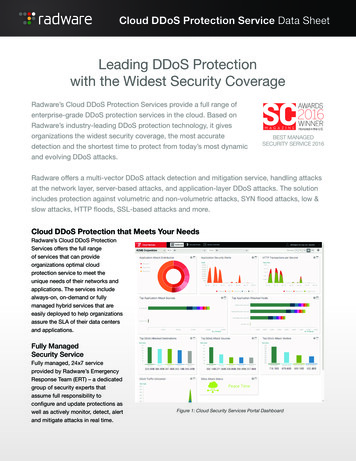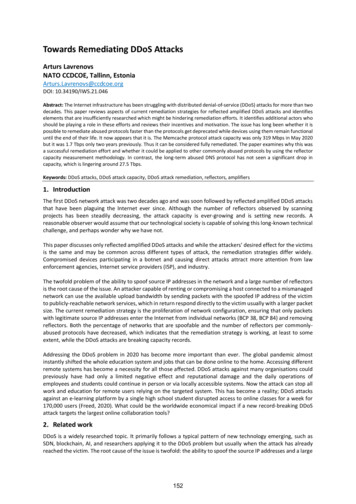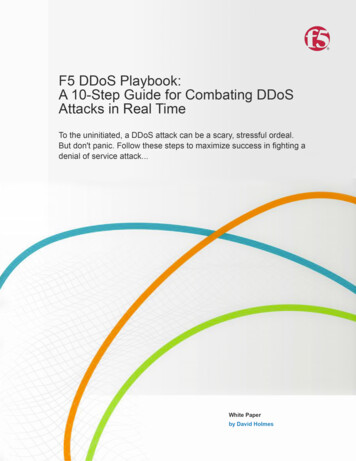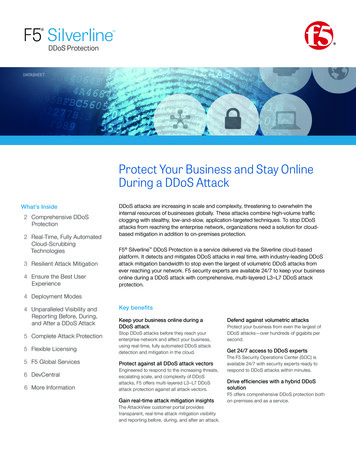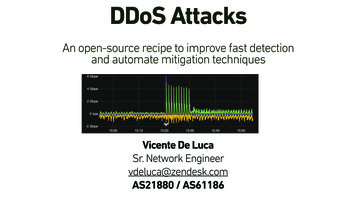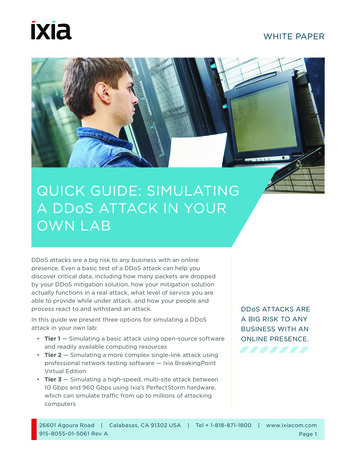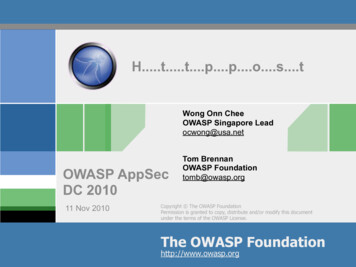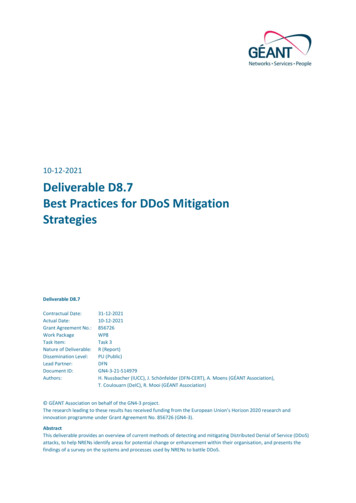
Transcription
10-12-2021Deliverable D8.7Best Practices for DDoS MitigationStrategiesDeliverable D8.7Contractual Date:Actual Date:Grant Agreement No.:Work PackageTask Item:Nature of Deliverable:Dissemination Level:Lead Partner:Document ID:Authors:31-12-202110-12-2021856726WP8Task 3R (Report)PU (Public)DFNGN4-3-21-514979H. Nussbacher (IUCC), J. Schönfelder (DFN-CERT), A. Moens (GÉANT Association),T. Coulouarn (DeIC), R. Mooi (GÉANT Association) GÉANT Association on behalf of the GN4-3 project.The research leading to these results has received funding from the European Union’s Horizon 2020 research andinnovation programme under Grant Agreement No. 856726 (GN4-3).AbstractThis deliverable provides an overview of current methods of detecting and mitigating Distributed Denial of Service (DDoS)attacks, to help NRENs identify areas for potential change or enhancement within their organisation, and presents thefindings of a survey on the systems and processes used by NRENs to battle DDoS.
Table of ContentsExecutive Summary11Introduction21.1Document Structure21.2Information Sources and Sensitivity21.3Scope22Detecting a DDoS Attack42.1Mechanisms for Detecting DDoS Attacks42.1.1NetFlow42.1.2Taps72.1.3Router CLI72.1.4Instinct92.23False Positives102.2.1Firewall Anomalies102.2.2State Table102.2.3Routing -Spoofing123.1.4Rate Limiting133.1.5Application/Server-Level Mitigation133.1.6Flowspec143.1.7BGP Diversion143.1.8Distribute Assets143.1.9Reduce Attack Surface153.1.10 External DDoS Mitigation Provider154Workflow and Communication175Status at NRENs195.1Survey195.2Categories245.2.1NRENs Who Have GÉANT as their Single Upstream245.2.2NRENs Who Also Cater to Governments255.2.3NRENS Who Service Schools and School Systems255.2.4NRENs with a Diverse Peering Strategy25Deliverable D8.7Best Practices for DDoS Mitigation StrategiesDocument ID: GN4-3-21-514979ii
Contents6Conclusions26References27Glossary29Table of FiguresFigure 2.1: Example of a NetFlow-based DDoS report: Flowmon5Figure 2.2: Example of a NetFlow-based DDoS report: FastNetMon6Figure 2.3: Example of a NetFlow-based DDoS report: DFN-NeMo7Figure 2.4: CLI query and results example: Cisco IOS XE8Figure 2.5: CLI query example: Cisco IOS XR9Figure 2.6: CLI query results example: Cisco IOS XR9Figure 5.1: Responses to Survey Q3: number of DDoS attacks detected per month19Figure 5.2: Responses to Survey Q4: type of monitoring system used20Figure 5.3: Responses to Survey Q5: DDoS protection system on NREN network20Figure 5.4: Responses to Survey Q6: systems used locally21Figure 5.5: Responses to Survey Q7: use of GÉANT FoD21Figure 5.6: Responses to Survey Q8: use of GÉANT DDoS Cleansing and Alerting service22Figure 5.7: Responses to Survey Q9: frequency of detection for different types of attack22Figure 5.8: Responses to Survey Q10: worst effect of DDoS attack23Figure 5.9: Responses to Survey Q12: interest in DDoS mitigation collaboration23Figure 5.10: Responses to Survey Q13: DDoS mitigation expenditure24Deliverable D8.7Best Practices for DDoS Mitigation StrategiesDocument ID: GN4-3-21-514979iii
Executive SummaryThis document provides an overview of current methods of detecting and mitigating DistributedDenial of Service (DDoS) attacks, to help National Research and Education Networks (NRENs) identifyareas for potential change or enhancement within their organisation’s DDoS mitigation strategy. Italso presents the findings of a survey on the systems and processes used by NRENs to battle DDoS.The primary mechanisms for detecting DDoS attacks are systems based on NetFlow (or comparabletechnologies, e.g. sFlow and IPFIX), network taps (physical and logical), and router command-lineinterface (CLI) queries. There will always be false positive alerts, possible causes of which could befirewall anomalies, state table and routing loops.There are numerous techniques for mitigating a DDoS attack, including remotely triggered black hole(RTBH), access control list (ACL), anti-spoofing, rate limiting, application/server-level mitigation,flowspec, Border Gateway Protocol (BGP) diversion, distribute assets, reduce attack surface andexternal DDoS mitigation, such as cloud-based solutions.Factors to consider in order to decide the most appropriate solution(s) include the proposed grade ofautomation as well as the size of the attacks to be mitigated within different points of the network.Whatever the technical solution(s) selected, an organisation needs to set up, in advance, processesfor who gets notified and who does what when a DDoS attack occurs. This involves pre-identifyingstakeholders and knowing how to contact them.During June 2021, a survey was sent to all GÉANT NRENs to gauge the systems and processes they useto battle DDoS; 20 NRENs responded. The findings indicate a diverse situation, which could be relatedto the different types of NREN. An attempt has therefore been made to categorise the various NRENtypes and assess the impact that type/category has on the solutions they might prefer for combattingDDoS attacks. The four categories are: NRENs who have GÉANT as their single upstream, NRENs whoalso cater to governments, NRENs who service schools and school systems, and NRENs with a diversepeering strategy.As most NRENs fall into multiple categories, a differentiated strategy might be the best way forwardat this time, together with enough trained personnel to successfully handle the workflows andcommunication that are required for effective DDoS attack handling.Deliverable D8.7Best Practices for DDoS Mitigation StrategiesDocument ID: GN4-3-21-5149791
1IntroductionWith Distributed Denial of Service (DDoS) attacks having long been a common network security threat,the GÉANT project tries to help the National Research and Education Network (NREN) community bysummarising the best current practices adopted by members of the community for handling theseattacks within the field of research networks.This document is intended to provide an overview of the current methods of detecting, handling andmitigating DDoS attacks. By introducing the different aspects of DDoS-attack handling, it enablesNRENs to identify areas in which there might be potential for change and enhancement within theirorganisation’s DDoS mitigation strategy.1.1Document StructureThis document first addresses the monitoring aspects of DDoS and how an organisation can determinewhether it is under DDoS attack (Section 2). It then covers the technical aspects of how to mitigate aDDoS attack (Section 3). Next it considers workflow and communication aspects: who needs to be keptin the loop and who needs to be notified when a DDoS attack occurs (Section 4). Finally, the documentpresents the situation at NRENs and what they have in place to handle DDoS attacks (Section 5), beforedrawing some general conclusions (Section 6).1.2Information Sources and SensitivityAll the contents of this document are either based on discussions within the NREN community and theGÉANT project and Association or are outcomes of surveys within this community. Due to the sensitivetopic as well as the proposed public dissemination of this document, no matching between techniques,mitigations, workflows and individual NRENs or research organisations is provided.1.3ScopeIn line with the intended purpose of this document, while it presents an overview of all relevantmethods to mitigate DDoS attacks, it does not aim to discuss what a DDoS attack is or what types ofDDoS attacks exist in the wild. In addition, no detailed in-depth guides for specific situations are given.However, the overview of the different aspects of DDoS-attack handling provided here should offerNRENs starting points for further implementation, and suggestions for further reading, including aDeliverable D8.7Best Practices for DDoS Mitigation StrategiesDocument ID: GN4-3-21-5149792
Introductiongood basic explanation of DoS attacks and the difference between DoS and DDoS attack techniques[Wiki DoSA], are provided in the References section at the end of this document.Deliverable D8.7Best Practices for DDoS Mitigation StrategiesDocument ID: GN4-3-21-5149793
Detecting a DDoS Attack2Almost all DDoS mitigation systems have some component which is intended to detect that theorganisation is under DDoS attack. The challenge for an NREN, university or institution is determininga baseline of what is normal. For a bank or insurance company, that is easily done, but in academia aresearcher could start downloading a 10TB dataset from 2–3 repositories which would be flagged asa DDoS attack. There will always be false positive alerts in any system and the trick is bringing downthe level of false positives to a bare minimum without missing the real attacks.This section covers primary mechanisms for detecting DDoS attacks, and some common causes offalse positive alerts.2.1Mechanisms for Detecting DDoS AttacksThe primary mechanism for determining whether an organisation is experiencing a DDoS attack is viaanomalies in data traffic patterns – usually in relation to volume, but for certain types of attacks thereare also other changes in the patterns. These changes in traffic patterns can often be observed usingwhatever network monitoring system is in place, usually fed with data from the routers. This data cantake the form of SNMP data, NetFlow (sFlow/IPFIX) exports, mirroring (via taps/SPAN ports), etc. Thissection covers: NetFlow. Taps. Router command-line interface.2.1.1 NetFlowThe primary system for determining whether an organisation is under DDoS attack is via a NetFlow (orcomparable technology) based system. Numerous NetFlow-based systems exist, some built into acommercial DDoS solution and some standalone.NetFlow was created by Cisco in 1996 and is a proprietary technology [NetFlow]. In general there arenetflow exporters, typically routers; netflow collectors, which merge and process all the flow dataarriving from all the different devices; and netflow analysis tools, which display the data in amanageable form – in the present case, DDoS analysis engines.NetFlow does not export payload data, only metadata. This would include the standard tuple fields(including source IP address, destination IP address, source port number, destination port number),Deliverable D8.7Best Practices for DDoS Mitigation StrategiesDocument ID: GN4-3-21-5149794
Detecting a DDoS Attackas well as some other parts depending on the version of NetFflow being used. NetFlow is already upto v9 (created in 2009), although the most common NetFlow version is v5. Due to the high volume offlows, most organisations will do “netflow sampling” – 1:10, or 1:100 and sometimes even 1:1000.sFlow, which stands for sampled Flow, is a technology created and owned by the sflow.org consortium[sFlow]. sFlow is limited in that it cannot handle 1:1 sampling. Sampling is an integral part of sFlow.Internet Protocol Flow Information Export (IPFIX) is an IETF protocol [IPFIX]. Both sFlow and IPFIX werecreated because people did not like the monopoly that Cisco has over export flow technology. Draftedin 2002–2003 and created in 2004, IPFIX used NetFlow v9 as a basis for the design.Nowadays, due to these three competing technologies, most router vendors support all threecommon flow technologies.NetFlow-based detection is obviously only possible when one has access to flow data relevant to theto-be-protected network. This might limit the use for systems hosted outside the organisation.One example of a NetFlow-based DDoS report is shown in Figure 2.1 below:Figure 2.1: Example of a NetFlow-based DDoS report: FlowmonAnother example is FastNetMon, which sends out emails with JSON:Deliverable D8.7Best Practices for DDoS Mitigation StrategiesDocument ID: GN4-3-21-5149795
Detecting a DDoS AttackFigure 2.2: Example of a NetFlow-based DDoS report: FastNetMonA final example of a NetFlow processing system is the DFN-NeMo system, an open source detectionand analysis tool developed by DFN to address the needs of a large NREN [NeMo]:Deliverable D8.7Best Practices for DDoS Mitigation StrategiesDocument ID: GN4-3-21-5149796
Detecting a DDoS AttackFigure 2.3: Example of a NetFlow-based DDoS report: DFN-NeMo2.1.2 TapsA network tap comes in two flavours: physical and logical. A physical tap would be a simple box whichtakes a fibre and, using tiny micro-mirrors, splits the traffic to one or more output ports. This way,numerous copies can be made of the incoming traffic so that it can be processed out of band. Thelogical method would be via what is known as a Switched Port Analyser (SPAN) or mirror port, wherebythe router itself duplicates the traffic and sends the duplicated traffic to a destination port.By diverting one of these “splits” to a packet sniffer system which uses tcpdump or Wireshark (packetanalysers), a network administrator can try to understand what is happening in the network. However,that is like trying to drink from a firehose. That is why it is customary to send the duplicated traffic toa dedicated, customised DDoS analysis engine similar to those mentioned in Section 2.1.1 above.The difference is that, with a network tap, there is no sampling and the traffic is 1:1.2.1.3 Router CLIBefore the existence of the dozens of different NetFlow analysis engines with their user-friendlygraphs and automated emails, the network administrator had to use the router command-lineinterface (CLI) as a tool to retrieve flow data and process it.An example of a Cisco IOS XE CLI query and its results is show in Figure 2.4:Deliverable D8.7Best Practices for DDoS Mitigation StrategiesDocument ID: GN4-3-21-5149797
Detecting a DDoS AttackOpenRtr#sho ip cache flowIP packet size distribution (502617M total packets):1-326496 128 160 192 224 256 288 320 352 384 416 448 480.001 .372 .040 .029 .018 .011 .012 .004 .005 .006 .006 .003 .002 .006 .001512 544 576 1024 1536 2048 2560 3072 3584 4096 4608.001 .002 .003 .026 .441 .000 .000 .000 .000 .000 .000IP Flow Switching Cache, 0 bytes199479 active, 521 inactive, 2239582258 added76834381 ager polls, 3106410521 flow alloc failuresActive flows timeout in 30 minutesInactive flows timeout in 15 secondslast clearing of statistics neverProtocolTotalFlowsPackets Bytes Packets Active(Sec) Idle(Sec)-------Flows/Sec/Flow /Pkt/Sec/Flow/FlowTCP-Telnet ther 65716212591 15300.75597 8UDP-other45467317891058.614 1181 07 17521.46700 /3/0.1te0/3/0.1te0/3/0.1te0/3/0.1 312.233.217.12712.233.185.231147.233.24.214Pr SrcP DstP06 ce48 aa3a06 bec7 4b5106 ce48 1cad06 d78f 857a06 d78f 6a9b06 bec7 493011 13ce 0401Pkts1111111Figure 2.4: CLI query and results example: Cisco IOS XEThe problem is that the list of individual flows can go on for many tens of thousands of lines, so somesort of scripting would be needed to aggregate results.Larger Cisco routers, which use IOS XR, have a slightly different CLI syntax to query flows. An examplequery is shown in Figure 2.5 below:Deliverable D8.7Best Practices for DDoS Mitigation StrategiesDocument ID: GN4-3-21-5149798
Detecting a DDoS Attackshow flow monitor fmp-nfsen cacheincl ipv4 protocolmatch ipv4 destination-address eq 128.139.0.0/16source-address destination-address layer4 source-port-overloadeddestination-port-overloaded eq 53 counterspackets sort counters packets top 100location 0/0/CPU0Figure 2.5: CLI query example: Cisco IOS XRThe resulting output would be as follows:Cache summary for Flow Monitor fmp-nfsen:Cache size:12000Current entries:12000Flows added:2701572382Flows not added:231027930651Ager Polls:14195856- Active timeout382405957- Inactive timeout2219156568- TCP FIN flag99997857- Emergency aged0- Counter wrap aged0- Total2701560382Periodic export:- Counter wrap0- TCP FIN flag0Flows 8.214.10142.250.179.17037.77.187.142 72979292118791460135813301220Figure 2.6: CLI query results example: Cisco IOS XRClearly a CLI cannot be used for constantly determining whether an organisation is under DDoS attack,but it does give the ability to quickly determine packet flows when no functioning NetFlow analysistool is available.2.1.4 InstinctOccasionally, one just has to rely on one’s instinct. It could be that the DDoS attack has started andthe organisation’s monitoring system requires 15–30 minutes to report on the attack. It could be thatsome new-style DDoS attack is taking place and the organisation’s monitoring system is not tuned topick it up. It could be that the DDoS attack is flying just under the thresholds needed for theorganisation’s system to send out an alert.In these cases, a trained and experienced network administrator will start suspecting a DDoS attack.Unfortunately, the number of tools available to the network administrator to quickly determinewhether an actual DDoS attack is taking place is limited.Deliverable D8.7Best Practices for DDoS Mitigation StrategiesDocument ID: GN4-3-21-5149799
Detecting a DDoS Attack2.2False PositivesThere are many times when it seems a DDoS is taking place when in fact it is not a DDoS at all butrather something that looks and feels like a DDoS attack. Possible causes of these false positivesinclude firewall anomalies, state tables and routing loops. Each of these is described below.2.2.1 Firewall AnomaliesIt may happen that something causes a firewall to act up. The users believe they are under DDoS attackand the network administrators will believe they are under DDoS attack when it is just a matter of afirewall that has failed. This can be caused by simply encountering a massive external port scan on alarge number of IP addresses which causes the state table in the firewall to have issues. Improperprotocol implementations can also cause unexpected issues. Often, a simple reboot of the firewall willclear out any stalled processes.2.2.2 State TableIt may not be only the firewall that has issues but any server – such as a web server – which can displayDDoS-like issues simply because its state table has filled up [STF]. This phenomenon can also be causedby port table exhaustion [PTE].2.2.3 Routing LoopsA simple error with regard to routing can cause packets to loop, which will be perceived as a DDoSattack.Deliverable D8.7Best Practices for DDoS Mitigation StrategiesDocument ID: GN4-3-21-51497910
Mitigations3There are numerous techniques a network administrator can use to try to mitigate a DDoS attack.Factors to consider in order to decide between them include the proposed grade of automation aswell as the size of the attacks to be mitigated within different points of the network.From discussions in the NREN community there seems to be a current consensus that the further awayfrom the end user a mitigation takes place, the less automation is needed. One could justify this viewby considering that an attack mitigation within the backbone of an NREN most possibly might affectmore network traffic and most possibly would be done with less knowledge about the attacked servicethan a countermeasure within a system placed directly in front of the attacked service.In addition, an NREN might decide that most brief DDoS attacks would not disturb the functionality ofits backbone in a way that would justify intercepting the network traffic by a mitigation, which could– as a side effect – even affect security research itself.The relevant mitigation techniques are as follows: Remotely triggered black hole (RTBH). Access control list (ACL). Anti-spoofing. Rate limiting. Application/server-level mitigation. Flowspec. Border Gateway Protocol (BGP) diversion. Distribute assets. Reduce attack surface. External DDoS mitigation.Each of these is described below.3.1.1 RTBHRemotely triggered black hole (RTBH) was first documented via RFC3882 “Configuring BGP to BlockDenial-of-Service Attacks” [RFC3882] but was presented in 2004 at North American NetworkOperators’ Group (NANOG) 30 in a presentation called “Customer-Triggered Real-Time Blackholes”[CTRTB].Deliverable D8.7Best Practices for DDoS Mitigation StrategiesDocument ID: GN4-3-21-51497911
MitigationsRTBH is based on Border Gateway Protocol (BGP) and requires setup prior to being attacked by DDoS.With RTBH, the customer triggers the RTBH activity via their BGP session with their ISP. There is aspecific BGP community that has to be used, as detailed in RFC7999 “Blackhole Community” [RFC7999].The customary community to use would be 65535:666, where 65535 means “no-export” (since onlythe upstream needs to hear the RTBH and no one else) and 666 is the registered RTBH number.In general, most ISPs will only want to accept a /32 (prefix length) as an RTBH and no larger prefix.Once the customer encounters the DDoS attack, they need to announce the victim IP (/32) via RTBHto their upstream, which has been pre-set to know what to do with such an announcement. Theupstream ISP now drops all traffic destined to the victim. This then becomes “destination-based RTBH”.Note that in 2004 this was considered state of the art, even though it meant that the victim waseffectively removed from the Internet. This was considered necessary in order to protect the other IPswhich were not being DDoSed at the time.There is an additional variant known as “source-based RTBH” [SBRTBH], in which by combining thestandard RTBH with Unicast Reverse Path Forwarding (uRPF) loose-checking on edge interfaces, theblackholing system can be utilised to block source IPs. Unfortunately, this was not widely implementedon the Internet, primarily because of the high level of difficulty.3.1.2 ACLAccess control lists (ACLs) should be considered an organisation’s first line of defence. It is possible topre-define preventative ACLs as well as on-demand specific ACLs.As an example of preventative ACLs, an organisation might consider blocking udp/0 and tcp/0. Eachorganisation can decide which ports should be blocked. Some might block external NetBIOS (tcp udp137–139), since this protocol should not be coming in from outside your organisation. Some mightpre-block defunct protocols such as Finger (tcp/79). Again, it is up to each organisation to determinewhich ports it wishes to pre-block and to inform its clientele.However, ACLs are usually used to block an existing attack. If the network administrator sees certainIPs or IP ranges DDoSing their network, they can institute an ACL to block all traffic from those specificIPs. But that will only work under certain, very limited circumstances.In general, when a DDoS happens, it will be coming from thousands of random IP addresses. It is quitedifficult to quickly build an ACL to block 3,000 IP addresses. The organisation can therefore decide toblock the victim IP via an ACL, and if the attack is targeted to a specific port on the victim IP, then anACL for a specific IP and destination port makes it an easy option to quickly block the attack.3.1.3 Anti-SpoofingIn order to cut down the attack footprint, anti-spoofing measures can be defined. An easy one todefine would be to not allow the organisation’s own network IPs to enter the network from abroad,as clearly someone has spoofed the organisation’s IPs and is using those spoofed IPs to be part of theDDoS attack. The technology used is called Reverse Path Forwarding (RPF) [RPF] and was initiallydefined in RFC2287 in 2000 [RFC2287]. Since then it has undergone a number of changes and uRPFDeliverable D8.7Best Practices for DDoS Mitigation StrategiesDocument ID: GN4-3-21-51497912
Mitigations(Unicast Reverse Path Forwarding) is now defined via RFC8704, “Enhanced Feasible-Path UnicastReverse Path Forwarding” [RFC8704].There are other anti-spoofing measures an organisation can take. No private IP addresses (RFC1918)[RFC1918] should be entering the network from abroad, so these too should be blocked. Anorganisation can also refer to the IANA table of special and reserved IP addresses [IANA SPAR] andsome of these, too, should be pre-blocked as an anti-spoofing method.3.1.4 Rate LimitingDDoS attacks come in many flavours and styles. Many ports can be used for amplification attacks, suchas udp/123 (NTP), tcp udp/19 (CHARGEN), tcp udp/17 (QOTD), which are known to have a highamplification factor. There are also tcp-syn floods, tcp-ack floods, syn-rst floods and any othercombination the imagination can conjure. All of these can be pre-rate-limited. If an organisation knowsthat the maximum bandwidth incoming for CHARGEN is 1 Mb/sec, it can rate-limit CHARGEN to 5Mb/sec. If an organisation knows that the maximum bandwidth ever seen for tcp-syns was 500 Mb/sec,it can pre-set a rate-limit for 1.5 Gb/sec for tcp-syns. It is very popular to rate-limit ICMPs. Anorganisation can select a target number and apply a rate limit to ICMP and not just ICMP echo requests.Rate limits can be defined based on source or destination. Destination rate limiting for a single IP maylead to unknown issues. Equally, rate limiting based on a single source IP first needs to be checked toensure that the IP is not some multi-use system and that by rate limiting it some service of which thenetwork administrator is not aware is hurt.Baselining and benchmarking are key to determining what thresholds to place on rate limiting –especially when based on ports. That is why it is difficult, since traffic patterns change over time. Mostnetwork administrators try to avoid using rate limiters when mitigating DDoS attacks and will just usean ACL to block the source or destination.3.1.5 Application/Server-Level MitigationIn general, a DDoS attack will affect an organisation’s entire network, not just one specific server.However, there are cases where the attackers target just one specific server via a DDoS attack. In thatcase, pre-planning can help mitigate the attack. Any server needs to have all the necessary resourcesto be able to function, such as an increased buffer size or many more threads than under normalconditions. The key is to over-provision the organisation’s critical servers so that even when hit withmassive numbers of requests they will not buckle.Occasionally, a load balancer can be inserted into the solution so as to distribute the increased loadamong multiple servers or even among different geographies. Another technique would be to employa firewall that is capable of geo-blocking. If the attack is coming from one specific country, then geoblocking is any easy solution to the DDoS attack.In general, however, DDoS attacks are not against specific servers but can be targeted against dormroom IPs or even non-allocated IP addresses within an organisation. When an organisation hasthousands of IP addresses, each and every one of them needs to be protected from DDoS attack.Deliverable D8.7Best Practices for DDoS Mitigation StrategiesDocument ID: GN4-3-21-51497913
Mitigations3.1.6 FlowspecFlowspec was created by the IETF back in 2009 (in RFC5575) but has undergone many revisions and isnow up to RFC8955, which came out in December 2020 [RFC8955]. Flowspec may be thought of asthe next generation of RTBH.Flowspec allows the matching of flows based on numerous fields, including src-ip, dst-ip, src-port,dest-port, ICMP code, packet length, DSCP, TCP flags and more. There is usually a primary Flowspecrouter which distributes flowspec rules to all the other routers in its ASN. The edge routers can bedirected to rate-limit, mark, redirect or drop traffic.In general, Flowspec is operated and managed within a specific ASN. Network operators do not yetfeel comfortable allowing Flowspec to cross ASN boundaries as they do with RTBH or using a specificcommunity to signal to drop traffic. A case in point would be the five-hour outage of one of the largestISPs in the world, CenturyLink/Level 3, which was caused by something related to Flowspec [CLL3O].3.1.7 BGP DiversionDiversion of traffic for the purposes of analysis, cleaning of malicious traffic and reinsertion into theInternet has been a game changer for handling DDoS attacks. In order to divert traffic, BGPannouncements are usually played with. One method is to announce a shorter prefix (for example,/24) than the announcement appearing on the Internet (for example, a /22). Another method is touse AS prepending in order to fictitiously lengthen the AS-path of the original victim. Another methodis to simply withdraw the prefix and allow the “diverter” to announce the original prefix. The mostcommon method is the first method – using a more specific prefix length.The easy part is diverting the traffic; the harder part is reinjecting the cleaned traffic back into theInternet. This requires delivering the traffic to the intended target and bypassing the diversion that istaking place on the Internet. This is usually accomplished via a GRE tunnel from the diverter to thevictim network whereby all the cleaned traffic c
This deliverable provides an overview of current methods of detecting and mitigating Distributed Denial of Service (DDoS) attacks, to help NRENs identify areas for potential change or enhancement within their organisation, and presents the findings of a survey on the systems and processes used by NRENs to battle DDoS. Deliverable D8.7 Best Practices for DDoS Mitigation Strategies Document ID .
